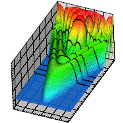Department of Physics and Astronomy: Publications and Other Research

Anthony F. Starace Publications
Document Type
Article
Date of this Version
October 2000
Abstract
We consider the use of strong static fields to control two related atomic processes: laser-assisted x-ray-atom scattering (XAS) and high-harmonic generation (HHG). We first analyze the laser field intensity dependence of the differential cross section (DCS) plateau structures for the laser-assisted XAS process in the presence of a static electric field as a function of the number of photons exchanged with the laser field. Besides the recently discovered (Milošević, D.B. and Starace, A.F., 1998, Phys. Rev. Lett., 81, 5097) extended plateau for absorbed photons, which indicates a substantial increase of the scattered x-ray energies, a new plateau, having many orders of magnitude larger DCS, appears for higher laser field intensities. We show furthermore a connection between this process and HHG. We also consider control of HHG with static electric and magnetic fields which are parallel to the laser polarization. The B field can considerably increase the harmonic emission rate (Milošević, D.B. and Starace, A.F., 1999, Phys. Rev. Lett. , 82,2653). The rate of a chosen harmonic is maximal whenever an integer multiple of the cyclotron period of the electron's motion perpendicular to the magnetic field is equal to the return time to the nucleus of the laser-field-generated electron wave packet in the intermediate state. While the B field has only a modest effect on the plateau cutoff positions, the static electric field can introduce additional plateaus and cutoffs. A properly chosen combination of static E and B fields can increase both the emission rate and the maximum harmonic order. The locations and magnitudes of the plateaus, both for XAS and HHG, are explained using the classical three-step model.


Comments
Published in Laser Physics, Vol. 10, No. 1, 2000, pp. 278-293. Original text copyight 2000 by Astro, Ltd.; copyright 2000 by MAIK "Nauka Interperiodica" (Russia). Used by permission.